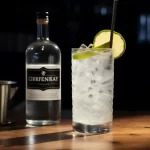Speakeasies were illicit drinking establishments that operated during the Prohibition era in the United States from 1920 to 1933. The term “speakeasy” originated from patrons having to speak quietly, or “easy,” to avoid drawing attention to the illegal activity. The prohibition of alcohol led to the rise of speakeasies, which became a cultural phenomenon, with their own unique atmosphere, music, and fashion. In this article, we will explore the history of speakeasies, their cultural impact, and their eventual downfall.
History of Speakeasies
The 18th amendment to the United States Constitution prohibited the manufacture, sale, and transportation of alcohol in the country. This led to the creation of an underground market for alcohol, which was supplied by bootleggers and smugglers. Speakeasies emerged as a response to the demand for alcohol, and they quickly became popular among people from all walks of life. Many speakeasies were located in basements, alleys, and back rooms of legitimate businesses.
Speakeasies were often run by organized crime syndicates, who saw the Prohibition as a business opportunity. These syndicates would pay off corrupt law enforcement officials to look the other way, or even provide them with a cut of the profits. Some speakeasies had secret entrances, hidden behind bookcases, false walls, or even in telephone booths.
Culture of Speakeasies
Speakeasies were more than just places to drink illegally. They were also places where people could socialize, dance, and listen to live music. Jazz music became synonymous with the speakeasy culture, with legendary musicians such as Louis Armstrong and Duke Ellington performing at these establishments. Speakeasies were also known for their fashion, with women wearing flapper dresses and men wearing zoot suits.
Speakeasies were seen as a symbol of rebellion against the establishment. The illegal nature of these establishments gave them an air of danger and excitement. People from all social classes would mix at speakeasies, which helped break down barriers between different groups of people.
The Downfall of Speakeasies
The end of the Prohibition era in 1933 spelled the end of speakeasies. With the legalization of alcohol, there was no longer a need for these establishments. Many of the people who frequented speakeasies moved on to legal bars and clubs, while others simply stopped drinking altogether.
The downfall of speakeasies was also due to increased law enforcement efforts. The federal government established the Bureau of Prohibition to enforce the Prohibition laws, and they targeted speakeasies as part of their efforts. Many speakeasies were raided and shut down, and their owners were arrested.
Conclusion
Speakeasies were a unique cultural phenomenon that emerged during a unique time in American history. They represented a rebellion against the establishment, and provided people with a place to drink, socialize, and listen to live music. The downfall of speakeasies was due to a combination of factors, including increased law enforcement efforts and the legalization of alcohol. However, the legacy of speakeasies lives on, as they continue to be romanticized in popular culture.
FAQs
What is a speakeasy?
- A speakeasy was an illicit drinking establishment that operated during the Prohibition era in the United States from 1920 to 1933.
Why were speakeasies illegal?
- Speakeasies were illegal because the 18th amendment to the United States Constitution prohibited the manufacture, sale, and transportation of alcohol in the country.
What was the culture of speakeasies?
- Speakeasies were not just places to drink, they were also places where people could socialize, dance, and listen to live music. Jazz music became synonymous with the speakeasy culture, with legendary musicians such as Louis Armstrong and Duke Ellington performing at these establishments. Speakeasies were also known for their fashion, with women wearing flapper dresses and men wearing zoot suits.
How did speakeasies operate?
- Speakeasies operated covertly, with patrons having to speak quietly or “easy” to avoid drawing attention to the illegal activity. Many speakeasies were located in basements, alleys, and back rooms of legitimate businesses. Some speakeasies had secret entrances, hidden behind bookcases, false walls, or even in telephone booths.
Why did speakeasies come to an end?
- The end of the Prohibition era in 1933 spelled the end of speakeasies. With the legalization of alcohol, there was no longer a need for these establishments. Many of the people who frequented speakeasies moved on to legal bars and clubs, while others simply stopped drinking altogether. Increased law enforcement efforts also contributed to the downfall of speakeasies.
How did speakeasies contribute to the culture of the time?
- Speakeasies represented a rebellion against the establishment and provided people with a place to socialize and connect with others from all walks of life. The music, fashion, and atmosphere of speakeasies helped shape the culture of the time and influenced popular culture for years to come.
What was the impact of speakeasies on American society?
- Speakeasies had a significant impact on American society, as they provided people with a way to rebel against the establishment and connect with others. They also helped shape the music and fashion of the time, which continues to influence popular culture to this day.
Were all speakeasies run by organized crime syndicates?
- No, not all speakeasies were run by organized crime syndicates. However, many speakeasies did have ties to organized crime, as they saw the Prohibition as a business opportunity.
How did the end of Prohibition affect American society?
- The end of Prohibition had a significant impact on American society, as it marked the end of a period of significant social change. The legalization of alcohol meant that people no longer had to drink covertly, which led to the rise of legal bars and clubs.
How have speakeasies been romanticized in popular culture?
- Speakeasies have been romanticized in popular culture through movies, television shows, and literature. They are often portrayed as glamorous, exciting places, where people can escape the mundane realities of everyday life. The music, fashion, and atmosphere of speakeasies have become iconic and continue to inspire artists and musicians to this day.









